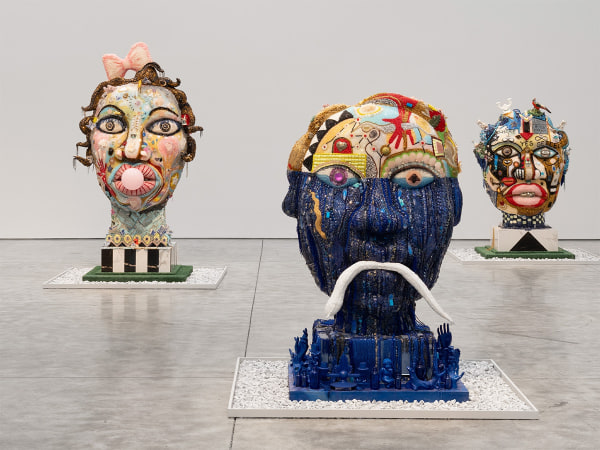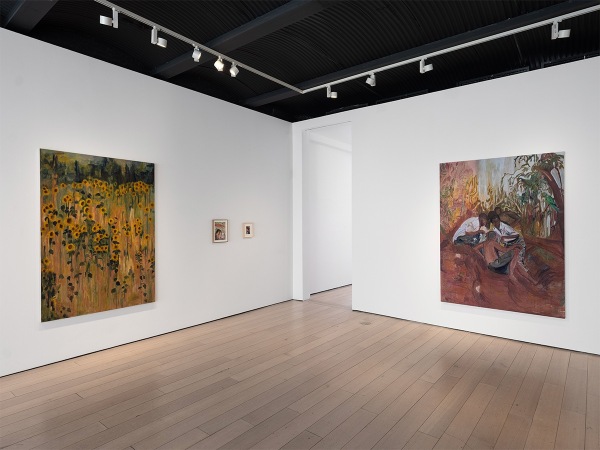Lee Krasner: The Edge of Color, Geometric Abstractions 1948–53
-
-
 Lee Krasner, Composition, 1949, oil on canvas, 38 1/16 x 27 13/16 inches, 96.7 x 70.6 cm. Philadelphia Museum of Art. Gift of the Aaron E. Norman Fund, Inc., 1959, 1959-31-1. © 2024 Pollock-Krasner Foundation / Artists Rights Society (ARS), New York. Courtesy of the Philadelphia Museum of Art.
Lee Krasner, Composition, 1949, oil on canvas, 38 1/16 x 27 13/16 inches, 96.7 x 70.6 cm. Philadelphia Museum of Art. Gift of the Aaron E. Norman Fund, Inc., 1959, 1959-31-1. © 2024 Pollock-Krasner Foundation / Artists Rights Society (ARS), New York. Courtesy of the Philadelphia Museum of Art. -
Key examples from Krasner’s “Little Image” series (1946–1950)—including Composition (1949), on loan from the Philadelphia Museum of Art; White Squares (c. 1948), on loan from the Whitney Museum of American Art; and Untitled (1948), on loan from The Jewish Museum—will visualize Krasner’s shifting style and working method at the end of the 1940s. Krasner began this series shortly after moving from Manhattan to Springs, NY, working flat on a table or on the floor and applying oil paint with a palette knife or directly from the tube. First building heavy impasto in the earliest works in this series, Krasner began to incorporate grid-like, “hieroglyphic,” and geometric motifs around 1948, after creating two important mosaic tables that earned Krasner her first critical praise. Comparable works are held by the Museum of Modern Art, New York, and the Metropolitan Museum of Art, New York, among other prominent collections.
On loan from the Carolyn Campagna Kleefeld Contemporary Art Museum, Gothic Frieze (1950) documents Krasner’s transition from her “Little Images” toward geometric imagery in the early 1950s. On view in New York for the first time in over 40 years, the work relates to a series of frieze-like “Personage” paintings that Krasner destroyed before ever exhibiting publicly—a series only known through studio photographs taken by Hans Namuth in Summer 1950. This work’s linear forms and somber palette anticipate major paintings like Gothic Landscape (1961, Tate), part of Krasner’s explosive “Umber” series created in the wake of her husband Jackson Pollock’s death in 1956, examples of which were presented at Kasmin in 2017.
Additional highlights include loosely-brushed compositions of side-by-side rectangles, not previously exhibited and likely realized just before Krasner began cutting and pasting her works from the Betty Parsons exhibition into her collage paintings. Painted on reused canvases, the underlying compositions, semi-visible from the reverse, are consistent with the paintings Krasner showed at Betty Parsons. These are paired with paintings of squares and rectangles in more complex arrangements, brushed in thin layers of paint. Employing compositional devices that create energetic spatial tension with color and form, the works instance a vibrancy that would soon hallmark Krasner’s career.
Krasner had experimented with geometric abstraction as early as the late 1930s, creating work in a distinctly Cubist idiom while studying with the celebrated German painter Hans Hofmann in 1937–40. In the early 1940s she exhibited with the avant-garde American Abstract Artists group, largely formed by geometric abstractionists like Josef Albers and Irene Rice Pereira; through this group Krasner met Piet Mondrian, who famously told her, “You have a very strong inner rhythm. Never lose it.” However sporadically, Krasner would later return to a geometric visual language, seen in the crisp forms of major paintings of the 1970s.
Kasmin Books will publish a fully-illustrated catalogue featuring new texts by Adam D. Weinberg, Director Emeritus of the Whitney Museum of American Art, and Jason Drill, Head of Research at Kasmin, replete with color plates, never-before-seen content, and related archival material in early 2024.
Previous solo exhibitions of Krasner’s work at Kasmin include Lee Krasner: Collage Paintings 1938-1981 (2021, catalogue), Lee Krasner: Mural Studies (2018), and Lee Krasner: The Umber Paintings, 1959-1962 (2017–18, catalogue). In 2021, the gallery presented a solo presentation of Krasner’s charcoal drawings at Art Basel in Basel, accompanied by a definitive catalogue.
Image above: Lee Krasner, Number 2, 1951. Jorge M. Pérez Collection. © 2024 Pollock-Krasner Foundation / Artists Rights Society (ARS), New York -
About the Artist

-
Join our Newsletter
* denotes required fields
We will process the personal data you have supplied in accordance with our privacy policy (available on request). You can unsubscribe or change your preferences at any time by clicking the link in our emails.
-
Explore
-

vanessa german: GUMBALL—there is absolutely no space between body and soul
April 3 – May 10, 2025 509 West 27th Street, New York, 514 West 28th Street, New YorkKasmin presents its second solo exhibition of new work by artist vanessa german (b. 1976), which debuts related bodies of sculpture across two of the gallery’s spaces in New York. GUMBALL—there is absolutely no space between body and soul deepens german’s singular approach to sculpture as a spiritual practice with the power to transform lived experience. Both series comprise mineral crystals, beads, porcelain, wood, paint and the energy that these objects bring to life to form monumental heads and figures in the act of falling. Together, each body of work envisions the transformation of consciousness necessary to imagine a new world. -

Helena Foster: Time Honoured
April 3 – May 3, 2025 297 Tenth Avenue, New YorkThe first New York solo exhibition of London-based painter Helena Foster features new oil paintings on linen, paper, and vellum that express the artist’s lyrical approach to painting as an accumulation of cultural and generational wisdom. Foster draws freely from literature, theater, film, Igbo oral tradition, and religion, achieving a dreamlike aura of mystery in dynamic compositions ambiguously set between thick vegetation and the built environment.
-
-
Explore
- Diana Al-Hadid
- Alma Allen
- Theodora Allen
- Sara Anstis
- Ali Banisadr
- Tina Barney
- Judith Bernstein
- JB Blunk
- Mattia Bonetti
- William N. Copley
- Cynthia Daignault
- Ian Davenport
- Max Ernst
- Liam Everett
- Leonor Fini
- Barry Flanagan
- Walton Ford
- Jane Freilicher
- vanessa german
- Daniel Gordon
- Alexander Harrison
- Elliott Hundley
- Robert Indiana
- Lee Krasner
- Les Lalanne
- Matvey Levenstein
- Lyn Liu
- Robert Motherwell
- Jamie Nares
- Nengi Omuku
- Robert Polidori
- Jackson Pollock
- Elliott Puckette
- Alexis Ralaivao
- George Rickey
- James Rosenquist
- Mark Ryden
- Jan-Ole Schiemann
- Joel Shapiro
- Bosco Sodi
- Dorothea Tanning
- Naama Tsabar
- Bernar Venet



